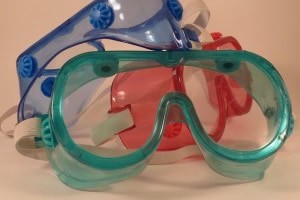 Print a Sign-In Sheet | Spanish Version
Print a Sign-In Sheet | Spanish Version
Eye injuries typically result from small particles or objects striking or abrading the eye. Examples include metal slivers, wood chips, dust, and cement chips that may be blown by the wind, may fall from above, or are ejected by tools. Some objects, such as nails, staples, or wood slivers, can result in permanent loss of vision if they penetrate the eyeball.
Potential eye hazards may occur from:
- Hammering, grinding, sanding, and masonry work that produces particles.
- Handling chemicals or cleaning products.
- Wet or powdered cement.
- Welding / thermal burns / UV burns.
- Dusty or windy conditions.
- Contact with contaminated fingers or objects.
What type of eye protection should you use?
The eye protection that best fits you will depend on your industry and risk assessment. Take into consideration the following elements to help determine what eye protection is suitable:
- Ability of the protection to protect against specific hazards.
- Proper fit and comfort.
- Unrestricted vision and movement.
- Durability.
- Unrestricted functioning of any other required personal protective equipment (PPE).
Some of the most common types of eye and face protection are:
Safety glasses
Glasses should have frames constructed of plastic or metal with impact-resistant lenses. Most glasses have side shields available or are built into the design of the glasses.
Goggles
Goggles completely cover the eyes, eye socket, and area surrounding the eyes. These are tight-fitting and provide protection from impact, dust, and splashes.
Welding shields
Constructed of vulcanized fiber or fiberglass and fitted with a filtered lens, welding shields protect eyes from burns caused by infrared or intense radiant light. They also protect both the eyes and face from flying sparks, metal spatter and slag chips produced during welding, brazing, soldering, and cutting operations. OSHA requires filter lenses to have an appropriate shade number to protect against the specific hazards of the work being performed.
Laser safety goggles
These specialty goggles protect against intense concentrations of light produced by lasers. The type of laser safety goggles an employer chooses will depend upon the equipment and operating conditions in the workplace.
Face shields
These transparent sheets of plastic extend from the eyebrows to below the chin and across the entire width of the employee’s head. Some are polarized for glare protection. Face shields protect against nuisance dusts and potential splashes or sprays of hazardous liquids but will not provide adequate protection against impact hazards. Face shields used in combination with goggles or safety spectacles will provide additional protection against impact hazards.
Controls
Remember, OSHA requires employers to assess the workplace to determine if hazards are present or are likely to be present, which necessitates the use of PPE. Engineering controls should be used to control and minimize eye injuries and to protect against the risk of ocular infection. PPE, such as goggles, face shields, safety glasses, or full face respirators, must also be used when an eye hazard exists.
After a hazard assessment, employers must select PPE and require employees to use it. Employers should communicate PPE selection decisions to employees and select PPE that properly fits employees. Employers must also train employees who are required to wear PPE regarding the following:
- Recognizing when PPE is necessary.
- Knowing the type of PPE necessary.
- Using PPE properly.
- Properly donning, adjusting, and wearing PPE.
- Properly maintaining PPE.
- Understanding the limitations of PPE in protecting employees from injury.
KEMI does not assume liability for the content of information contained herein. Safety and health remain your responsibility. This information is to be used for informational purposes only and not intended to be exhaustive or a substitute for proper training, supervision or manufacturers’ instructions/recommendations. KEMI, by publication of this information, does not assume liability for damage or injury arising from reliance upon it. Compliance with this information is not a guarantee or warranty that you will be in conformity with any laws or regulations nor does it ensure the absolute safety of any person, place or object, including, but not limited to, you, your occupation, employees, customers or place of business.

